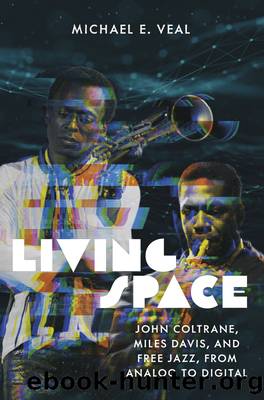Living Space by Michael E. Veal

Author:Michael E. Veal
Language: eng
Format: epub
Publisher: Wesleyan University Press
Published: 2024-02-23T00:00:00+00:00
XI: CURVED SPACE
Our ship was funneled directly through the center of the sunâ
and out the other side ⦠But the instruments recorded our path.
We had gone straight through the nova.175
Samuel Delany
He carried me away in the spirit to a great and high mountain,
and showed me that great city, the Holy Jerusalem,
descending out of heaven from God.
The Holy Bible, Revelation 21:10
If Rashied Ali had introduced the concept of âmultidirectionalâ rhythm into Coltraneâs music, his concept is also a fitting thematic lens through which to view Coltraneâs reality at the beginning of 1967. The previous year had arguably been his most contentious ever as a bandleader. Hailed as the avatar of a revolutionary new music and received abroad in a manner reserved for the worldâs greatest artists, he was simultaneously having his appearances at home terminated by club owners and audiences who found his new music intolerable.176 On the other hand, a close listening to the studio recordings he made during February and March (eventually released as Stellar Regions, Interstellar Space, and Expression) reveals refinements in his music that give lie to the Coltrane-went-into-free-jazz-and-lost-all-perspective narrative. In the big picture, however, his overall level of activity was rapidly decreasing; he was accepting fewer gigs and increasingly avoiding the public eye as the symptoms of what would eventually be diagnosed as liver cancer sapped his strength and vitality. Between January and July, he is documented as having performed only three concerts, and he was only in the studio for four recording sessions.177 And although it is a bit too convenient to make such interpretations in retrospect, the elegiac tone of many of these final pieces has often been taken as a sign that Coltrane was already contemplating his mortality.178
The decrease in activity does not imply a decrease in musical development; Coltraneâs recordings of early 1967 arguably comprise a period of consolidation that resolved the transformative growth spurt of spring 1965. If the live recordings of 1966 can essentially be heard as ritual documents, the 1967 studio sessions were much more transparent presentations of Coltraneâs design thinking at the time. Taken as a whole, they suggest emotional focus, conceptual clarity, and a sense of calm after the proverbial storm of the previous year. Essentially, it was on these recordings that the saxophonistâs time spent staring at the stars seemed to pay its most obvious dividends: definitively liberated from the constraints of meter and the restrictive harmonic cycles of bebop, his final music might be heard as not only an act of devotion or testimony, but also as a spiritually charged inquiry into the nature of space.
Part of this is likely attributable to the fact that the ensemble has been scaled down to the core quartet for these sessions. There are no additional drummers or percussionists present and, for the most part, Pharoah Sanders does not participate on these sessions despite the fact that he remained a regular member of Coltraneâs working group (the one piece that includes Sanders features him on flute).179 This is not
Download
This site does not store any files on its server. We only index and link to content provided by other sites. Please contact the content providers to delete copyright contents if any and email us, we'll remove relevant links or contents immediately.
Cecilia; Or, Memoirs of an Heiress — Volume 1 by Fanny Burney(32495)
Cecilia; Or, Memoirs of an Heiress — Volume 2 by Fanny Burney(31909)
Cecilia; Or, Memoirs of an Heiress — Volume 3 by Fanny Burney(31887)
The Great Music City by Andrea Baker(31755)
We're Going to Need More Wine by Gabrielle Union(19001)
All the Missing Girls by Megan Miranda(15766)
Pimp by Iceberg Slim(14433)
Bombshells: Glamour Girls of a Lifetime by Sullivan Steve(14020)
For the Love of Europe by Rick Steves(13509)
Talking to Strangers by Malcolm Gladwell(13284)
Norse Mythology by Gaiman Neil(13274)
Fifty Shades Freed by E L James(13185)
Mindhunter: Inside the FBI's Elite Serial Crime Unit by John E. Douglas & Mark Olshaker(9259)
Crazy Rich Asians by Kevin Kwan(9216)
The Lost Art of Listening by Michael P. Nichols(7452)
Enlightenment Now: The Case for Reason, Science, Humanism, and Progress by Steven Pinker(7271)
The Four Agreements by Don Miguel Ruiz(6696)
Bad Blood by John Carreyrou(6581)
Weapons of Math Destruction by Cathy O'Neil(6206)
